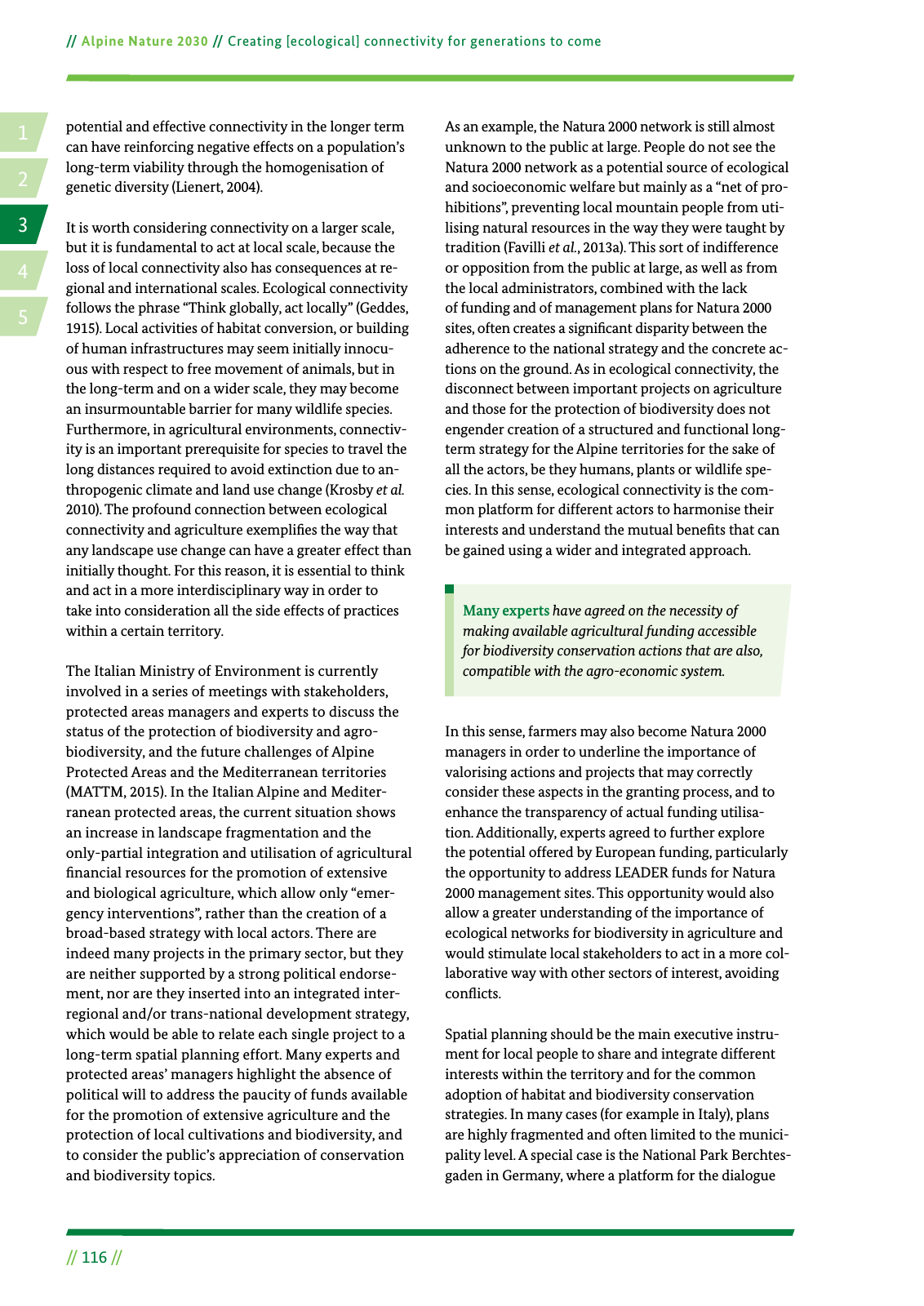14 2 5 3 Alpine Nature 2030 Creating ecological connectivity for generations to come 116 potential and effective connectivity in the longer term can have reinforcing negative effects on a population s long term viability through the homogenisation of genetic diversity Lienert 2004 It is worth considering connectivity on a larger scale but it is fundamental to act at local scale because the loss of local connectivity also has consequences at re gional and international scales Ecological connectivity follows the phrase Think globally act locally Geddes 1915 Local activities of habitat conversion or building of human infrastructures may seem initially innocu ous with respect to free movement of animals but in the long term and on a wider scale they may become an insurmountable barrier for many wildlife species Furthermore in agricultural environments connectiv ity is an important prerequisite for species to travel the long distances required to avoid extinction due to an thropogenic climate and land use change Krosby et al 2010 The profound connection between ecological connectivity and agriculture exempli es the way that any landscape use change can have a greater effect than initially thought For this reason it is essential to think and act in a more interdisciplinary way in order to take into consideration all the side effects of practices within a certain territory The Italian Ministry of Environment is currently involved in a series of meetings with stakeholders protected areas managers and experts to discuss the status of the protection of biodiversity and agro biodiversity and the future challenges of Alpine Protected Areas and the Mediterranean territories MATTM 2015 In the Italian Alpine and Mediter ranean protected areas the current situation shows an increase in landscape fragmentation and the only partial integration and utilisation of agricultural nancial resources for the promotion of extensive and biological agriculture which allow only emer gency interventions rather than the creation of a broad based strategy with local actors There are indeed many projects in the primary sector but they are neither supported by a strong political endorse ment nor are they inserted into an integrated inter regional and or trans national development strategy which would be able to relate each single project to a long term spatial planning effort Many experts and protected areas managers highlight the absence of political will to address the paucity of funds available for the promotion of extensive agriculture and the protection of local cultivations and biodiversity and to consider the public s appreciation of conservation and biodiversity topics As an example the Natura 2000 network is still almost unknown to the public at large People do not see the Natura 2000 network as a potential source of ecological and socioeconomic welfare but mainly as a net of pro hibitions preventing local mountain people from uti lising natural resources in the way they were taught by tradition Favilli et al 2013a This sort of indifference or opposition from the public at large as well as from the local administrators combined with the lack of funding and of management plans for Natura 2000 sites often creates a signi cant disparity between the adherence to the national strategy and the concrete ac tions on the ground As in ecological connectivity the disconnect between important projects on agriculture and those for the protection of biodiversity does not engender creation of a structured and functional long term strategy for the Alpine territories for the sake of all the actors be they humans plants or wildlife spe cies In this sense ecological connectivity is the com mon platform for different actors to harmonise their interests and understand the mutual bene ts that can be gained using a wider and integrated approach Many experts have agreed on the necessity of making available agricultural funding accessible for biodiversity conservation actions that are also compatible with the agro economic system In this sense farmers may also become Natura 2000 managers in order to underline the importance of valorising actions and projects that may correctly consider these aspects in the granting process and to enhance the transparency of actual funding utilisa tion Additionally experts agreed to further explore the potential offered by European funding particularly the opportunity to address LEADER funds for Natura 2000 management sites This opportunity would also allow a greater understanding of the importance of ecological networks for biodiversity in agriculture and would stimulate local stakeholders to act in a more col laborative way with other sectors of interest avoiding con icts Spatial planning should be the main executive instru ment for local people to share and integrate different interests within the territory and for the common adoption of habitat and biodiversity conservation strategies In many cases for example in Italy plans are highly fragmented and often limited to the munici pality level A special case is the National Park Berchtes gaden in Germany where a platform for the dialogue

Hinweis: Dies ist eine maschinenlesbare No-Flash Ansicht.
Klicken Sie hier um zur Online-Version zu gelangen.
Klicken Sie hier um zur Online-Version zu gelangen.